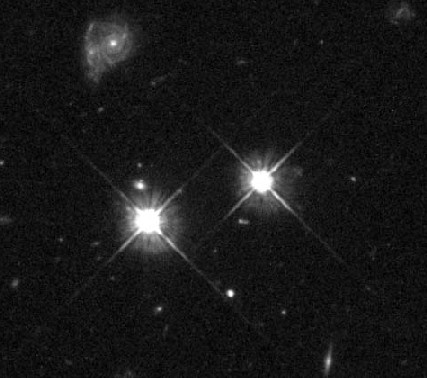
Which is the quasar and which is an ordinary star? (The quasar is the bright one on the left.)
Courtesy of Space Telescope Science Institute
This material (including images) is copyrighted!. See my copyright notice for fair use practices. Select the photographs to display the original source in another window. Links to external sites will be displayed in another window.
When the universe was younger, some galaxies produced a lot more radiation than galaxies do today. A typical galaxy shines with the energy from billions of stars and is tens of thousands of light years (or more) across. A peculiar group of galaxies are extremely luminous but very compact. The light from these active galaxies is produced by a strange process in the centers of the galaxies. Sometimes starburst galaxies are grouped with these peculiar galaxies, but here I will consider an ``active galaxy'' to be a galaxy with a very luminous nucleus. The great luminosity of starburst galaxies is not confined to their nucleus.

 Maarten Schmidt solved the mystery in 1963. In order
to figure out the
structure of the atoms producing the bizarre spectra, he set out to construct
an energy level diagram from the pattern of the emission lines. He made some
mistakes in his calculations because his calculations were not showing the
regularity he could clearly see in the spectrum of a radio source called
3C 273 (the 273rd object in the third Cambridge catalog of radio sources). As a
test of the regularity he compared the spectrum of 3C 273 with the spectrum of
hydrogen. He was shocked because the pattern was the same but greatly redshifted!
3C 273 is moving
at a speed of 47,400 kilometers/second (almost 16% the speed of light!).
The Hubble-Lemaître Law says that this blue radio object is far outside the Galaxy. The
other radio ``stars'' were also at great distances from us. They are called quasi-stellar radio sources or quasars for short. Later, some other
blue star-like objects at large redshifts were discovered to have no radio
emission, but they are still called quasars.
Maarten Schmidt solved the mystery in 1963. In order
to figure out the
structure of the atoms producing the bizarre spectra, he set out to construct
an energy level diagram from the pattern of the emission lines. He made some
mistakes in his calculations because his calculations were not showing the
regularity he could clearly see in the spectrum of a radio source called
3C 273 (the 273rd object in the third Cambridge catalog of radio sources). As a
test of the regularity he compared the spectrum of 3C 273 with the spectrum of
hydrogen. He was shocked because the pattern was the same but greatly redshifted!
3C 273 is moving
at a speed of 47,400 kilometers/second (almost 16% the speed of light!).
The Hubble-Lemaître Law says that this blue radio object is far outside the Galaxy. The
other radio ``stars'' were also at great distances from us. They are called quasi-stellar radio sources or quasars for short. Later, some other
blue star-like objects at large redshifts were discovered to have no radio
emission, but they are still called quasars.
What is strange about the quasars is not their great distance, but, rather, their incredible luminosities. They are hundreds to thousands of times more luminous than ordinary galaxies. Yet, all of this energy is being produced in a small volume of space. Their luminosity varies on time scales of a few months to as short as a few days. Remember from the discussion of pulsars and black holes in the stellar evolution chapter that the light fluctuation time scale from any object gives you an estimate of the maximum possible size of the object. The maximum size = (speed of light) ×(light fluctuation time interval). The quasars that vary their light output over a few months are about the size of our solar system. This is tens of thousands of times smaller than a typical galaxy!
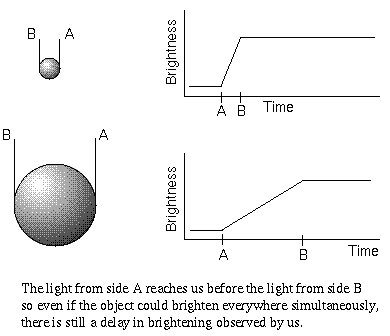
The shape of the continuous part of a quasar spectrum is also quite unusual. Stars are luminous in primarily the visible (optical) band of the electromagnetic spectrum. The hottest stars also emit a significant fraction of their light in the ultraviolet band and the coolest stars emit a significant fraction of their light in the infrared band. Regardless of the star, though, the spectrum of a star, and, hence, the spectrum of a normal galaxy, rises to a peak at some wavelength determined by the temperature (remember Wien's law?) and drops off at wavelengths shorter or longer than the peak wavelength. Such a spectrum is called a thermal spectrum because it depends on just the temperature.
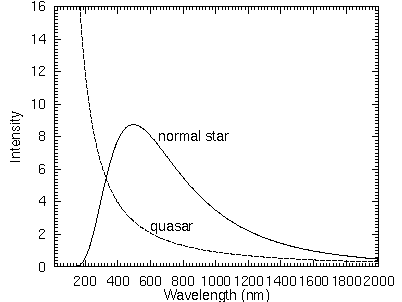
Quasars have a decidedly non-thermal spectrum: they are luminous in the X-rays, ultraviolet, visible, infrared, and radio bands. They have about the same power at all of the wavelengths down to the microwave wavelengths (shortwave radio wavelengths). The spectrum looks like the synchrotron radiation from charged particles spiraling around magnetic field lines at nearly the speed of light (remember the emission from pulsars?).
Perhaps the quasars are not as far away as the Hubble-Lemaître Law says from their redshifts. If their large redshifts are due to some powerful explosive event that shot the quasars out at some tremendous speed, then you would not have to worry about the tremendous luminosities. That would be nice, but unfortunately (or fortunately, if you like a good mystery) that does not appear to be the case. Quasars are found in clusters of galaxies. The galaxies are much fainter than the quasars so only the largest telescopes can gather enough light to create a spectrum for those far away galaxies. Their spectra also have the same large redshift of the quasars in the cluster. Also, some quasars are close enough to us that some fuzz is seen around them. The color of the fuzz is like that of normal galaxies. The spectra of the fuzzy patches around the bright quasar shows that the light from the fuzz is from stars.
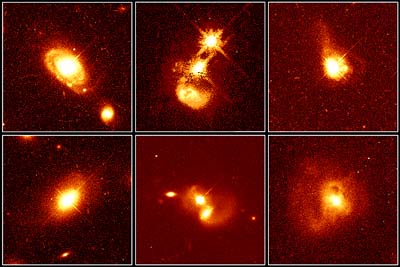
In addition, the gravitational lensing of quasars by distant galaxies is only possible if the lensed quasars are farther away than the galaxy bending the quasar's light. Quasars are the exceptionally bright nuclei of galaxies!
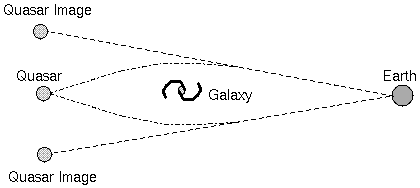
![]() Go back to previous section --
Go back to previous section --
![]() Go to next section
Go to next section
last updated:
June 28, 2022
Is this page a copy of Strobel's
Astronomy Notes?